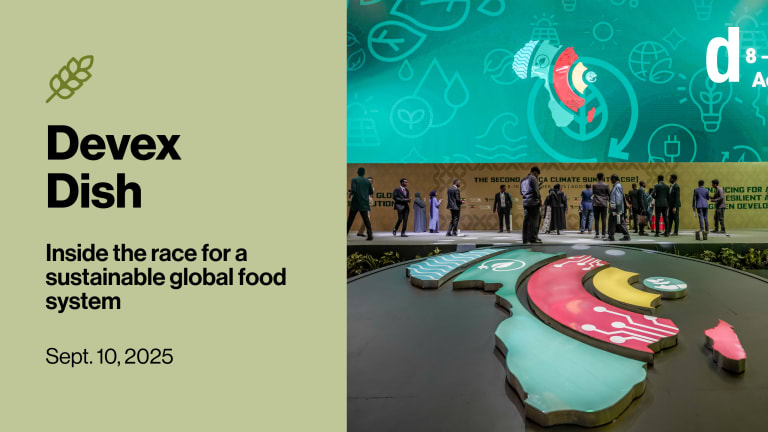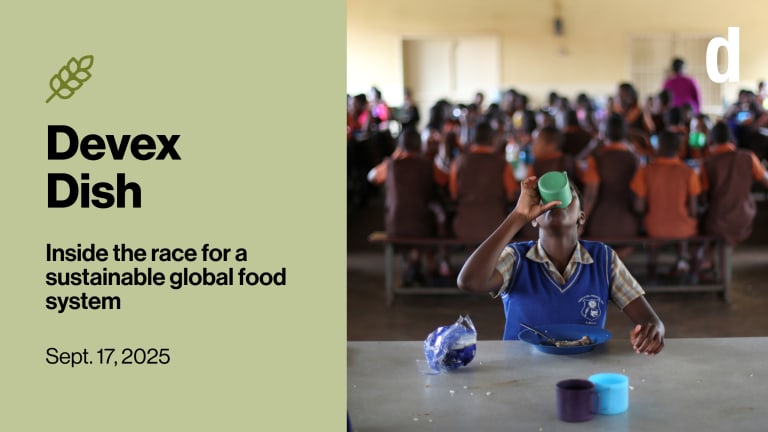
Last weekend at the Stockholm Food Forum, I found myself wavering between hope and despair. Hope, because the latest EAT-Lancet report launched there outlined how we can produce enough food for nearly 10 billion people through a system that is healthy, sustainable, and just. And despair, because the climate trajectory we are on will require massive shifts in how we go about doing so — shifts that feel nearly impossible amid entrenched interests, political polarization, and the short-term focus of many of today’s governments.
By now I am sure you’ve read the landmark 78-page report — or at least my much shorter news story about it. A big takeaway is that food systems are critical to bringing us back from the brink of climate disaster. They generate approximately 30% of greenhouse gas emissions, and without drastic transformation, our existing systems would push the warming of the planet beyond the 1.5 degrees Celsius threshold laid out in the 2015 Paris climate agreement, even if fossil fuels are phased out.
“Transforming the food system, on the other hand, can cut global emissions by more than half,” Johan Rockström, co-chair of the EAT-Lancet commission, told an audience of 700 leaders across science, business, politics, and civil society. At present, seven of the nine planetary boundaries have been crossed — meaning that we are slowly making our environment unsafe for humanity — and food systems are the biggest driver of five of those breaches.
And transforming food systems comes with a hefty price tag. The report estimates that it’ll cost somewhere between $200 billion and $500 billion — but that it could generate financial returns of $5 trillion a year through better health, a more resilient climate, and restored ecosystems. So who will pay? “It’s got to be everyone, everywhere, all at once,” Anna Lappé, executive director of the Global Alliance for the Future of Food, a group of philanthropic foundations, said during a panel in Stockholm. That means international financial institutions, the private sector, governments, and everyone in between.
The business case for investing in transforming food systems is actually very clear, said Máximo Torero, chief economist of the Food and Agriculture Organization. “It’s not enough to understand the benefits in the present value of today, but it’s also important to understand how we can put incentives together to create cooperation,” he said at the same panel. He pointed to the Global Alliance Against Hunger and Poverty, a G20 initiative launched by Brazil last year, as an example of bringing together financing, governments, and proven policies that work. “Because if we don’t coordinate and we don’t cooperate,” he added, “we won’t be able to achieve the goal.”
Numerous ideas for where to direct the money were put forward in Stockholm. High on the list is public procurement of food, an area where governments, particularly at the municipal level, spend hundreds of billions of dollars — perhaps even trillions — each year on programs such as school meals.
“Farmers don’t grow out of choice. Farmers grow by interpreting market signals and government policies which include procurement,” said Ajay Vir Jakhar, chair of the Farmers Forum of India. “And that’s why procurement is so important, because it drives what farmers grow and how they grow it.”
But at this time, farmers bear a hugely disproportionate share of the risks associated with growing the world’s food — and thus, are also set to bear many of the costs of changing it. The European Union alone sees €28 billion annually in losses from extreme weather, with most of it shouldered by farmers, according to Rowan Douglas, CEO of climate risk and resilience at Howden Group, a reinsurer. That figure is only set to get worse.
Anyone paying attention knows that global cooperation in an era of so much polarization is a challenge. But in closing the gathering in Stockholm, food futurist Jack Bobo argued that people won’t be inspired to act if they think we are doomed, or if food systems change is only ever framed in terms of sacrifices.
“We talk about problems and solutions, but we need to prove to people that change is possible,” he said, reminding the audience to consider the progress made in health and nutrition in the past 200 years. “We need people to understand that in so many ways, things are not bad and getting worse. They are good and getting better, but not fast enough. That’s an invitation to work together and solve the problem.” The next 25 years, in which the world’s population will hit nearly 10 billion in 2050 before decreasing due to the falling birth rate, are “the most important years there will ever be” in the history of agriculture, he added.
So despite the despairing facts and figures in Stockholm, Bobo’s words left me choosing hope.
Read: Planet at risk — new EAT-Lancet report warns food system overhaul is vital
See also: Inside Brazil’s plan to cut world hunger by 2030
And don’t miss: Agrifood systems come with $11.6 trillion in hidden costs driven by poor diets
Bad apples
How can change happen amid a flood of misinformation and public mistrust? That is a major challenge for the climate, nutrition, and public health sectors, as two experts told me during a panel I moderated in Stockholm.
The first EAT-Lancet report, published in 2019, was criticized in the agrifood sector for going overboard in recommending less animal-source protein — a major source of emissions — in its plant-focused “planetary health diet” and for being inaccessible or unaffordable for people in the global south. But it also saw fierce backlash on social media. An extremely well-timed report last month by the Changing Markets Foundation outlined how a web of what it calls “mis-influencers” fueled most of that backlash — and that many were backed by a public relations firm called Red Flag that represents a meat and dairy industry alliance.
“Misinformation is one of the major threats to science,” said Theresa Marteau, a behavioral psychologist at the University of Cambridge who served on the EAT-Lancet commission. “The failure to protect evidence from misinformation is what stops effective action from citizens and governments, leading to delay, dilution, and derailment of effective interventions.”
So how can trust in science be rebuilt? Marteau and nutrition scientist Kevin Hall recommended tighter controls on social media — such as content moderation and penalties for companies that allow misinformation to circulate — as well as increasing the accessibility and intelligibility of scientific facts, while also protecting policymakers from the influence of lobbyists. It’s also important to admit when we’re wrong or just don’t know. “The idea that we can just trust the experts is something that’s relegated to the past,” said Hall, who left his job at the U.S. National Institutes of Health in April over concerns that the Trump administration was censoring his work on ultra-processed foods.
From our archives: Can the EAT-Lancet diet work for the global south?
You can’t teach an old dog new-trition
Meanwhile in Geneva, experts from private finance and the public sector gathered last week at the Building Bridges conference to discuss ways to make investing in nutrition profitable and attractive to investors.
The World Bank estimates that every dollar invested in nutrition brings a $23 return through improved children’s health, cognition, and workforce productivity. Investable projects include nutritional supplements, breastfeeding promotion, and large-scale food fortification. Yet, similar to food systems transformation, investors often view the benefits of investing in nutrition as long-term, diffuse, and spread across sectors — which makes nutrition a difficult sell for investors seeking quick, measurable returns, writes my colleague Elissa Miolene.
Despite significant private-sector investment in food and agriculture, most capital doesn’t go toward healthy food but rather ultra-processed options. “The problem is not the money. It’s not the capital. It’s what the capital is seeking to achieve,” says Greg Garrett, the executive director of the Access to Nutrition Initiative, or ATNi. The Netherlands-based foundation tries to push the private sector toward healthier food systems by benchmarking companies on their nutrition policies and urging investors to tie financing to stronger standards.
Efforts like ATNi aim to shift incentives — showing that investing in better nutrition can protect long-term returns, reduce regulatory risk, and meet growing consumer demand for healthier foods. And nutrition experts are hoping that a combination of government regulation and changing consumer preferences could create more interest and opportunities for impact-minded investors.
Read: What’s the business case for investing in nutrition?
See also: Can finance fix the future? Building Bridges takes a shot
The big bank theory
Onward to Washington, where agriculture will take center stage at next week’s World Bank and International Monetary Fund annual meetings. The flagship event set for Tuesday — Mission AgriConnect: Farms, Firms, and Finance for Jobs — will look at how smallholder farmers, who produce about 80% of the world’s food, can gain better access to finance, technology, and markets to support jobs and food security.
Bringing home the bacon
Your next job?
Senior Impact Investment Manager
Global Impact Investing Network
United States (remote)
The World Bank has been sharpening its focus on agriculture since President Ajay Banga announced last year that the institution would double its annual agribusiness financing to $9 billion by 2030.
Indeed, the shift is clear in the bank’s 2025 priorities for agriculture and food. The agenda includes driving more coordinated action on food and nutrition security through its new Global Challenge Program, scaling “planet-healing” solutions such as agroforestry, water-efficient farming, and methane reduction technologies. And putting more weight on nutrition-sensitive agriculture to expand access to healthy diets.
Still, there are a number of open questions, especially related to the $9 billion figure: how much of the promised money has actually gone out the door, where it’s being directed, and how well the bank’s different arms — including the International Finance Corporation — are working together. Those will be key points to watch next week.
Background: World Bank doubles agribusiness investment to $9 trillion in strategy shift
+ Next week, we’ll be live in Washington, D.C., hosting panel discussions, one-on-one interviews, and producing behind-the-scenes reporting at the Devex Impact House on the sidelines of the World Bank-IMF annual meetings.
On the food systems front, we’ll have a session with IFC Global Head for Agribusiness Anup Jagwani to dive deeper into the World Bank’s agribusiness financing. Register now to join us in person or virtually from Oct. 15–16.
Chew on this
“Natural capital” aims to reframe nature not as an expendable resource, but as its own asset class. The problem? No one can decide how to value it. [Devex]
Nestlé has left the Dairy Methane Action Alliance, an effort launched at COP28 to reduce greenhouse gas emissions from herds of cattle. [Bloomberg]
How demand for farmed fish in Dutch supermarkets is undermining food security in West Africa. [DeSmog]
Demand for meat, milk, and eggs is growing. Digital tools can boost productivity while keeping livestock emissions in check. [Devex Opinion]
Ayenat Mersie contributed to this edition of Devex Dish.








